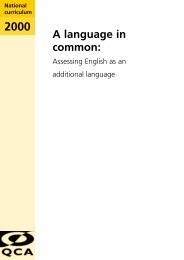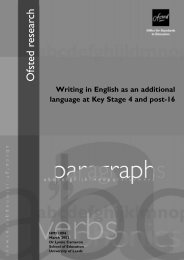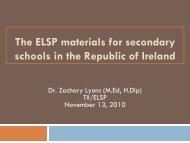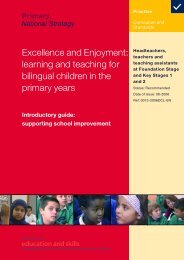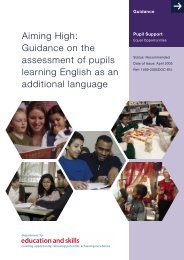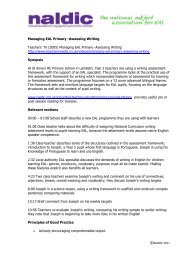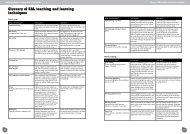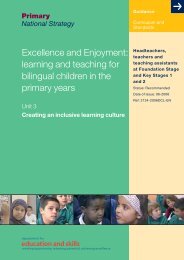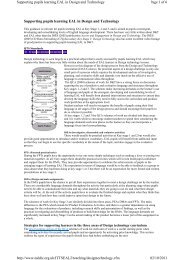Creating a learning culture: Making it work in the classroom - NALDIC
Creating a learning culture: Making it work in the classroom - NALDIC
Creating a learning culture: Making it work in the classroom - NALDIC
You also want an ePaper? Increase the reach of your titles
YUMPU automatically turns print PDFs into web optimized ePapers that Google loves.
• use of multi-sensory activ<strong>it</strong>ies and stimulat<strong>in</strong>g resources, <strong>in</strong>clud<strong>in</strong>gICT, to keep learners engaged;• daily teach<strong>in</strong>g which uses ongo<strong>in</strong>g as well as formal assessmentto re<strong>in</strong>force and build on previous <strong>learn<strong>in</strong>g</strong>, w<strong>it</strong>h carefully plannedprogression of skills and knowledge as well as planned <strong>in</strong>terventionw<strong>it</strong>h appropriate add<strong>it</strong>ional support when required;• regular opportun<strong>it</strong>ies to apply <strong>the</strong> skills of decod<strong>in</strong>g and to read textfor mean<strong>in</strong>g. Texts which young readers use to practice read<strong>in</strong>gshould <strong>in</strong>clude enjoyable l<strong>it</strong>erature w<strong>it</strong>h rich vocabulary, repet<strong>it</strong>ionof phrases and sentences, frequently used words which are notphonemically regular and phonemically regular words.section 2It is important that early phonic <strong>work</strong> is taught successfully w<strong>it</strong>h<strong>in</strong> alanguage-rich curriculum. For young children, effective <strong>work</strong> draws onall areas of <strong>learn<strong>in</strong>g</strong> of <strong>the</strong> Foundation Stage curriculum to developchildren’s imag<strong>in</strong>ation and enrich <strong>the</strong>ir communication skills,particularly speak<strong>in</strong>g and listen<strong>in</strong>g. For young bil<strong>in</strong>gual learners, <strong>the</strong>secommunication skills need to develop <strong>in</strong> first and add<strong>it</strong>ional languages.It is also important to recognise that children’s phonemic awareness <strong>in</strong><strong>the</strong>ir first language should be built on to develop <strong>the</strong>ir understand<strong>in</strong>gof phonics for read<strong>in</strong>g and wr<strong>it</strong><strong>in</strong>g <strong>in</strong> English. Bil<strong>in</strong>gual learners whohave already learned to read and wr<strong>it</strong>e <strong>in</strong> <strong>the</strong>ir first language usuallylearn phonics for read<strong>in</strong>g and wr<strong>it</strong><strong>in</strong>g <strong>in</strong> English very easily and issuescreated by very specific differences <strong>in</strong> sound systems can be addressedexplic<strong>it</strong>ly.The l<strong>in</strong>k between oral and wr<strong>it</strong>ten language comprehension:‘develop<strong>in</strong>g speak<strong>in</strong>g and listen<strong>in</strong>g and <strong>in</strong>tensify<strong>in</strong>g languagecomprehension <strong>in</strong> English as precursors to read<strong>in</strong>g and wr<strong>it</strong><strong>in</strong>g,<strong>in</strong>clud<strong>in</strong>g phonic <strong>work</strong>’ (Rose 2006) is particularly important forchildren <strong>learn<strong>in</strong>g</strong> English as an add<strong>it</strong>ional language. It is also importantthat word recogn<strong>it</strong>ion and comprehension are taught w<strong>it</strong>h<strong>in</strong> a broadand rich curriculum which reflects as well as extends <strong>the</strong> learners’<strong>culture</strong>s, ident<strong>it</strong>ies and experiences.Rose (2006) draws on Gough and Turner’s ‘simple view of read<strong>in</strong>g’as consist<strong>in</strong>g of decod<strong>in</strong>g and comprehension to provide a conceptualframe<strong>work</strong>. Decod<strong>in</strong>g is <strong>the</strong> abil<strong>it</strong>y to recognise words presented s<strong>in</strong>glyout of context us<strong>in</strong>g phonic rules. Comprehension is languagecomprehension (<strong>the</strong> process by which lexical, sentence and discourseare <strong>in</strong>terpreted) and not just read<strong>in</strong>g comprehension. A common setof l<strong>in</strong>guistic processes is held to underlie comprehension of both oraland wr<strong>it</strong>ten language.Primary National Strategy | 2133-2006DCL-EN | © Crown copyright 2006Excellence and Enjoyment: <strong>learn<strong>in</strong>g</strong> and teach<strong>in</strong>g for bil<strong>in</strong>gual children <strong>in</strong> <strong>the</strong> primary yearsUn<strong>it</strong> 2: <strong>Creat<strong>in</strong>g</strong> <strong>the</strong> <strong>learn<strong>in</strong>g</strong> <strong>culture</strong>: mak<strong>in</strong>g <strong>it</strong> <strong>work</strong> <strong>in</strong> <strong>the</strong> <strong>classroom</strong> 31




